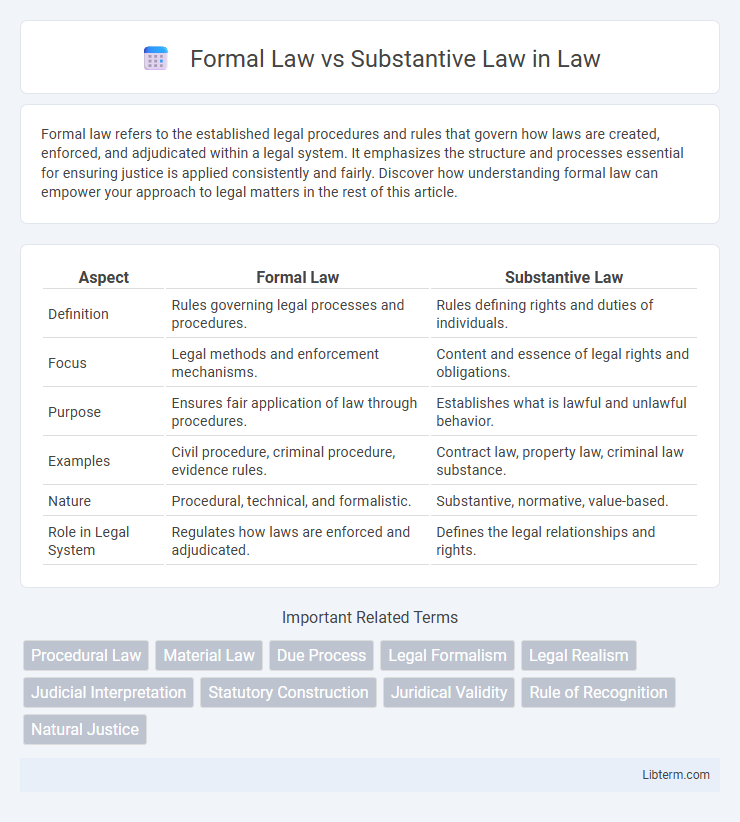Formal law refers to the established legal procedures and rules that govern how laws are created, enforced, and adjudicated within a legal system. It emphasizes the structure and processes essential for ensuring justice is applied consistently and fairly. Discover how understanding formal law can empower your approach to legal matters in the rest of this article.
Table of Comparison
| Aspect | Formal Law | Substantive Law |
|---|---|---|
| Definition | Rules governing legal processes and procedures. | Rules defining rights and duties of individuals. |
| Focus | Legal methods and enforcement mechanisms. | Content and essence of legal rights and obligations. |
| Purpose | Ensures fair application of law through procedures. | Establishes what is lawful and unlawful behavior. |
| Examples | Civil procedure, criminal procedure, evidence rules. | Contract law, property law, criminal law substance. |
| Nature | Procedural, technical, and formalistic. | Substantive, normative, value-based. |
| Role in Legal System | Regulates how laws are enforced and adjudicated. | Defines the legal relationships and rights. |
Understanding Formal Law: Definition and Scope
Formal law, also known as procedural law, governs the methods and means by which substantive law is administered and enforced, including rules for legal processes such as jurisdiction, pleadings, evidence, and trial procedures. It establishes the framework that ensures the fair application of substantive legal rights and obligations by regulating court procedures and the function of legal institutions. Understanding formal law is crucial for recognizing how legal systems maintain order and deliver justice through standardized protocols.
Defining Substantive Law: Core Principles
Substantive law establishes the fundamental rights and duties that govern behavior, such as property rights, contracts, and torts, defining what actions are lawful or unlawful. It sets the legal standards and principles that dictate how individuals interact within society, including criminal laws and civil rights. Unlike formal law, which outlines procedural steps, substantive law provides the essential rules that determine the outcomes of legal disputes.
Key Differences Between Formal Law and Substantive Law
Formal law defines the procedures and methods for enforcing rights and duties, such as rules of evidence and court protocols. Substantive law outlines the actual rights and obligations of individuals, including laws related to contracts, crimes, and property. The key difference lies in formal law addressing the "how" of legal processes, while substantive law determines the "what" of legal rights and responsibilities.
Historical Development of Formal and Substantive Law
Formal law, also known as procedural law, originated from ancient legal systems that emphasized the processes and methods courts must follow to enforce rights, especially prominent in Roman law and later codified in civil law traditions. Substantive law, focusing on the actual rights and duties of individuals, evolved concurrently as societies recognized the need to define legal relationships and conduct clearly, with significant development during the Enlightenment and the rise of natural law theories. The historical development of both formal and substantive law reflects the balance between orderly judicial processes and the substantive content of justice, shaping modern legal systems worldwide.
Importance of Formal Law in Legal Systems
Formal law establishes the procedural framework essential for enforcing rights and obligations within legal systems, ensuring consistency, predictability, and fairness in judicial processes. It provides the necessary rules for litigation, evidence, and adjudication, enabling the effective application of substantive law. Without formal law, substantive rights would lack practical enforcement mechanisms, undermining the rule of law and legal certainty.
The Role of Substantive Law in Justice Delivery
Substantive law defines the rights and duties of individuals, shaping the core principles of justice by establishing what is legally right or wrong. It guides courts in delivering fair judgments by providing the substantive content necessary for legal decisions, unlike formal law which focuses on procedural rules. The effective enforcement of substantive law ensures equitable outcomes and upholds the rule of law within the justice system.
Interaction Between Formal and Substantive Law
The interaction between formal law and substantive law shapes the legal framework by balancing procedural mechanisms with the rights and duties defined by substantive law. Formal law establishes the rules and processes for enforcing rights and obligations, while substantive law defines those rights and obligations themselves. Effective legal systems depend on the coherence between procedural rules and substantive principles to ensure justice is both enacted and upheld.
Examples Illustrating Formal versus Substantive Law
Formal law governs the procedures and methods by which legal rules are applied, such as rules of evidence and court procedures, while substantive law defines the actual rights and duties, like contract obligations or criminal offenses. For example, formal law dictates how a trial is conducted, whereas substantive law determines whether a defendant is guilty of theft. Another instance is the difference between procedural rules for filing a lawsuit (formal) and the legal principles that establish breach of contract (substantive).
Impacts on Legal Proceedings: Formal vs Substantive Approaches
Formal law shapes legal proceedings by establishing strict procedural rules that ensure consistency, fairness, and order in the administration of justice. Substantive law directly impacts the outcome by defining rights, duties, and liabilities that determine the legal merits of a case. The interplay between formal and substantive approaches influences judicial decision-making, affecting case duration, appeal processes, and enforceability of judgments.
Challenges and Reforms in Balancing Both Laws
Balancing formal law, which governs procedural rules, with substantive law, defining legal rights and duties, creates challenges such as procedural delays and inconsistent application of justice. Reforms often target enhancing procedural efficiency without compromising substantive fairness, emphasizing clearer legal standards and streamlined court processes. Embracing technology and alternative dispute resolution mechanisms also aims to harmonize formal and substantive elements for equitable outcomes.
Formal Law Infographic

 libterm.com
libterm.com